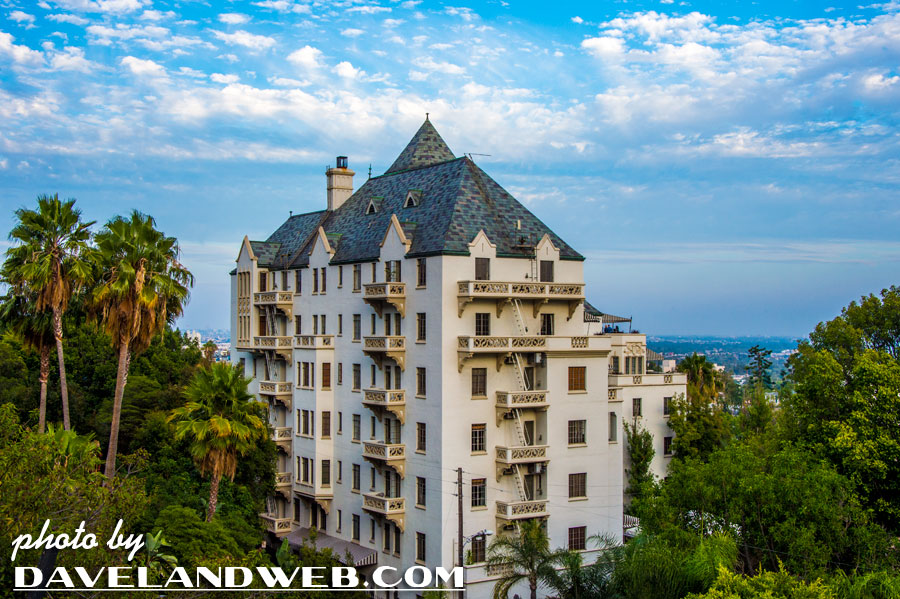
My oasis of the west, the Chateau Marmont Hotel. Ever wondered where the name came from? The word “Chateau” is pretty simple; it’s French for fancy home. If you want to get technical, the noun is…:
a large French country house or castle, often giving its name to wine made in its neighborhood
I’m not aware of any wine being made here, but Attorney Fred Horowitz was inspired by the Chateau Amboise (seen on his recent trip to France) and decided that his apartment complex was going to be modeled after it. It also happens to be where Leonardo da Vinci is buried. Designed by his brother-in-law (a positive example of nepotism), Arnold A. Weitzman, the corner of Marmont Lane and Sunset Boulevard was the location where this seven-story Chateau would be built. “Chateau Horowitz” didn’t seem to have the same amount of appeal as “Chateau Marmont,” so the Attorney decided to name it after the street instead. Want to know where the name of the street came from? First, I’ll tell you the oft told legend. See this guy below chewing on his pipe, silent screen star Percy Marmont:

The British actor had a modestly successful career. Witzel of Hollywood took this moody black and white photo of Percy.

For a little more about Witzel, I found this on the National Portrait Gallery of Australia website:
Witzel Studios was founded in Los Angeles by photographer Albert Walter Witzel (1879–1929) in 1909 and within a few years had become one of the city’s foremost portrait studios. The rise of the business paralleled the emergence of the film industry following its relocation from the east coast, and Witzel was soon in demand from Hollywood studios seeking to create interest in movies by circulating promo shots of their stars. Distinguished by moody lighting and dramatic poses and settings, Witzel’s photos soon set the tone for Hollywood studio photography and from the mid-1910s they featured frequently in fan magazines like Photoplay, becoming an important promotional and publicity tool. Witzel occasionally worked on assignment for the big picture studios, photographing many silent film luminaries including Theda Bara and Charlie Chaplin. Witzel’s business began to decline in the 1920s, by which time the relentless publicity machine had resulted in movie studios employing their own teams of photographers. Witzel Studios folded following Albert Witzel’s death in 1929.
I have often wondered why the Lane was named after Percy Marmont, a now unknown British actor who I assumed must have been traveling in the right social circles at the right time.

And then on the Instagram account LA Street Names I read this:
Marmont Lane was named in 1921 on a tract owned by a dozen investors, none of whom were Percy Marmont. The man himself wouldn’t become a (semi) movie star or even move to Hollywood until late 1923, so there’s zero chance that he inspired this street name. “Marmont” is most likely a portmanteau of mar and monte – Spanish for “sea” and “mountain” – alluding to its hilly views of the Pacific, although two of the tract’s owners were Paul and Zida Marlay, for whom nearby Marlay Drive is named, so the “Mar” might be for them.
Regardless, the address of the Hotel is Sunset Boulevard, but you have to turn onto Marmont Lane to get to it. Go figure.

The Marmont name can be seen on the exterior:

Don’t think that Fred didn’t leave his mark on the apartment building (which converted to a hotel in 1931). See the “H” on the exterior of the wall of Room 54?

Let me zoom in a little closer for you:

And there you have it. The story behind the name. Or at least as much as I could dig up.
See more Chateau Marmont photos at my main website.

1 comment:
I never knew any of that. Everything was a surprise. Chateau Horowitz would have been good too, but it doesn't continue the roll of French from "Chateau" into "Marmont" as well. Hopefully the city doesn't rename the street "Belushi Lane" any time soon. Chateau Belushi would turn into a house of animals.
Post a Comment